The vast majority of insects live alone (solitary). But among insects, there are also some that truly live a social life (or social life, gregarious life). The most famous ones are bees, termites and ants. The standard of social life should be: they live together in a big family and lead a collective life. The members of the big family have different grades (types) and a clear division of labor. They each perform their duties, maintain group life in an orderly manner, and reproduce their offspring. .
Why is the division of labor in social insects so clear? Some people think this is their instinct; but now more people think it is because of the "food reciprocity" relationship between members of each class. Taking bees as an example, before the queen bee lays eggs, the worker bees clean the hive; when the queen bee lays eggs, there are always many worker bees taking care of it; when the queen bee rests, the worker bees take turns feeding it; when the queen bee walks in the nest, the nest All the other bees inside give way to it, and so on. Some people may ask this question: Why do tens of thousands of worker bees respect, obey and serve the queen bee so much? Scientists have found that the queen bee itself can secrete a special substance from the maxillary gland in the mouthparts. The substance is spread all over the queen bee's body. The worker bees like this substance and often eat sweets on the queen bee's body. This substance can prevent the development of the ovaries of worker bees, and also has the function of directing the behavior of worker bees, forming different hierarchies within the bee colony. This substance is the "queen substance", which is actually a hormone, also known as a behavior-regulating hormone. After analysis, it was found that this hormone is an unsaturated fatty acid, and people have successfully conducted artificial synthesis experiments. Queens of termites and ants also secrete this substance. There is only some understanding of the behavior-regulating hormones of social insects, and their nature and regulatory mechanisms are still under investigation.
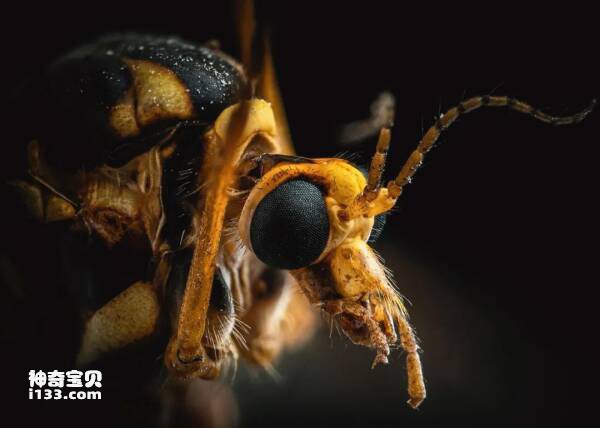
bee
Bees belong to the order Hymenoptera and family Apidae. The body is 8-20 mm long, yellowish brown or dark brown, with dense hairs. The head and chest are nearly as wide. The antennae are knee-shaped, the compound eyes are oval and hairy, the mouthparts are chewing and sucking, and the hind legs are powder-carrying feet. Two pairs of membranous wings; the forewings are large and the hind wings are small, and the front and rear wings are linked by hooks. The abdomen is nearly oval, with less body hair than the chest, and there are pincers at the end of the abdomen. Bees undergo complete metamorphosis and go through four stages of life: egg, larvae, pupa and adult.
In bee society, they still live a matriarchal clan life. Among the members of the large family of their group, there is a queen bee (queen bee), which is a reproductive female bee who is responsible for laying eggs and reproducing offspring, and at the same time "ruling" the large family. Although the queen bee has mated, not all the eggs she lays are fertilized. According to the needs of the large group family, it can lay fertilized eggs that will develop into female bees (non-reproductive worker bees) in the future; it can also lay unfertilized eggs that will develop into drone bees in the future. When the large family members of this group multiply too much and cause overcrowding, they will be divided into groups. The process of swarming is as follows: the worker bees create a special hive - the royal platform, where the queen bee lays fertilized eggs; after the larvae hatch, the worker bees are given special treatment and fed with the highly nutritious royal jelly produced in their bodies. Hey, when this little larva develops into an adult, it will become a new queen bee with reproductive capacity. The new queen bee will lead some worker bees to fly to establish a new colony. Apis cerana Fabr. and A. mellifera L. are both commonly raised beneficial insects. During the breeding process, after the new queen bee is born, it must be manually divided into groups. Otherwise, a queen bee will lead a group of worker bees to fly away from the hive and the colony will be lost. Beekeepers use artificial methods to produce royal jelly. In fact, they make some artificial royal jelly and put it in the beehive for the queen bee to lay eggs. When the larvae hatch and the worker bees are fed with royal jelly, the beekeeper will take out the royal jelly. . In fact, beekeepers use deception, which shows that even smart bees are sometimes deceived.
There are many drones, there may be nearly a thousand in a group. The only duty of the drone is to mate with the queen bee. During the mating, the queen flies out of the nest and is followed by the drones in the swarm. This is called a nuptial flight. The queen bee selects a mate through flight competition, and only the winner becomes the mate. After mating, the drone's genitals fall off into the queen bee's genitals. At this time, the drone completes its life mission and dies. Those drones that failed to mate with the queen returned to the nest and only knew how to eat and drink, but did not know how to collect honey. They became unnecessary lazy bees in the bee colony. As time goes by, the Gongfeng will expel them. Beekeepers are also unwilling to keep too many drones in the colony and consume honey, so they are artificially culled. From this point of view,
Worker bees are the most numerous in this group. The number of worker bees that beekeepers maintain in a bee colony varies depending on the season, but is generally between 20,000 and 50,000 worker bees. Worker bees are the most industrious. The children's song "little bees, busy all day long, collecting nectar and making honey" only refers to worker bees. In addition to collecting pollen and making honey, worker bees also have tasks such as building nests, feeding larvae, cleaning the environment, and defending the colony. From spring to late autumn, when plants are blooming, bees are busy every day. Winter is the only short period of leisure for bees. However, cold weather and low temperatures in the hive are detrimental to bees, because bees are cold-blooded animals, and their body temperature changes with the temperature of the surrounding environment. The extraordinarily intelligent little bee has come up with a special way to resist the cold. When the temperature in the hive is as low as 13°C, they move closer to each other in the hive and form spherical clusters. The lower the temperature, the tighter the clusters, which reduces the surface area of the hive and increases the density to prevent excessive cooling. According to measurements, at the coldest time, the temperature inside the bee ball can still be maintained at around 24°C. At the same time, they also eat more honey and exercise more to generate heat to increase the temperature inside the nest. When the weather is cold, the surface temperature of the bee ball is lower than that of the center of the ball. At this time, the bees on the surface of the good ball drill toward the center of the ball, while the bees in the center of the ball move outward. In this way, they take care of each other, constantly exchange positions, and survive the cold weather. Winter. How do they eat the honey stored in the hive during the overwintering period? Smart bees have their own tricks. They do not need to disband the sphere and crawl out to get food. Instead, they obtain food by passing it to each other. This can keep the temperature inside the sphere constant or less changing, which is beneficial to safe overwintering.
Termites
Termites, also known as insects. The bodies of termites are weak and flat, and can be white, light yellow, russet or dark brown. The body colors of various species are different. The mouthparts are typically chewing and the antennae are bead-shaped. There are long-winged, short-winged and wingless types. The winged species have two pairs of long and narrow membranous wings. The size, shape and venation of the wings are similar, so they are called Isoptera. After a short flight, termite wings can fall off from the unique transverse slits at the base.

Termites are social insects that live in groups and have complex organizational divisions of labor. Individuals within a group can be divided into two major types in terms of morphology and division of labor, namely reproductive and non-reproductive.
l. Reproductive type: They are sexual female and male ants. Their duty is to maintain old colonies and create new colonies. There are three levels in this type.
1) Large-winged or winged type: The body is ossified, yellow, brown or black, with two pairs of well-developed wings. After losing its wings, it can become the father and mother ants that create a new colony. Every spring and summer. In the sultry evening after rain, a large number of long-winged breeding ants suddenly fly out from the ant nest and fly low near the building not far from the nest. The flight time is very short. This phenomenon is called nuptial flight or swarm flight ( group). The swarms of ants were flying low in the sky, as if they were having a dance party, each freely choosing their partner without restraint. Those who like each other fly to the ground, take off their wings, and the male and female chase each other in pairs, usually the male before the female, to complete the important event of marriage, find a suitable place, build a new nest, lay eggs, breed offspring, and establish a new group. This pair of newly married male and female ants will be the mother and father of the new colony in the future, and they will also be the queen and king of the new colony. The couple lived a lifelong monogamous life in a civilized society. Termite nuptial flight swarms can often be seen in places south of the Yangtze River in my country, but not all individuals in the nuptial flight can form new colonies in pairs. When they fly out in large numbers, they are often eaten by various birds, predatory insects or other animals. Eaten, only a few of them tie the knot and become partners. Even though they are a minority, they are enough to maintain the reproduction of their race and cause harm to wooden buildings.
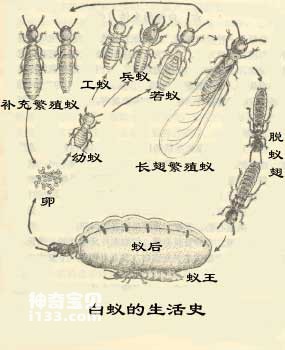
(2) Short-winged type: It is called the supplementary reproductive type and is more common among ground-dwelling species.
(3) Wingless type: They are also supplementary reproductive ants, completely wingless individuals. Only exists in extremely primitive types.
2. Non-reproductive type: refers to termites without the ability to reproduce. They are wingless and have degraded reproductive organs. They are mainly responsible for labor and combat tasks, so they are divided into worker ants and soldier ants.
(1) Worker ants: They are the most numerous in the ant colony and are responsible for many complicated tasks in the nest, such as building ant mounds, digging tunnels, building ant roads, cultivating bacterial beds, collecting food, raising young ants and soldier ants, and caring for ant eggs, etc. . Among non-soldier ant species, they are also responsible for defending against foreign enemies.
(2) Soldier ants: Although they are divided into male and female, they cannot reproduce. The head of the soldier ant is long and highly ossified, and the upper jaw is well-developed, but it has lost its function of feeding and has become a weapon to defend against enemies. The upper jaw can also be used to block holes, ant passages or the entrance to the palace. Since the soldier ants have lost their feeding function, food is fed by the worker ants. There are two types of soldier ants: Large-jawed soldier ants - the upper jaw forms various strange shapes, like a large two-toothed fork. Elephant Trunk Soldier Ant - The head extends into the shape of an elephant trunk. When it fights an enemy, it can spray out colloidal secretions to smear the enemy.
Termites are a progressive metamorphosis species with incomplete metamorphosis and a complex life history. Termites can be divided into two categories according to their living habits. First, wood-dwelling termites: colonies of varying sizes build nests in hollow parts of wooden buildings, such as wooden doors and windows, wooden floors, wooden houses, railway sleepers, wooden bridges, dead trees, etc., and feed on the wood. Fiber is a major pest of wood products. The wood is hollowed out and the building is prone to collapse. Railway sleepers are infested, which affects their service life and poses a great threat to traffic safety. The second is soil-dwelling termites: they build nests in the soil below the ground, or the nests are tower-shaped above the ground, which are called ant mounds. Soil-dwelling termites feed on trees, leaves and fungi.
Speaking of termites feeding, there is another interesting thing. According to "Lingnan Miscellaneous Notes" (written by Wu Zhenfang) published during the Kangxi period, in 1684 AD, thousands of taels of silver were found missing from a yamen bank. Officials were frightened and searched everywhere but failed to find them. Later, some shiny white coins were found under the wall. They dug up a termite nest under the corner of the wall. The officials were puzzled at the time, so they put the termites into the furnace and burned them to death. As a result, silver was burned out. If this record is true, there is no doubt that termites can eat silver. There have been reports of termites eating metal and cables in my country and abroad, but it is impossible to find out what kind of termites they are. Termites are mainly distributed in tropical and subtropical areas, and are more common in provinces south of the Yangtze River in my country.
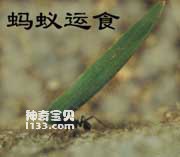
Ant
Ants belong to the order Hymenoptera, family Formicidae. Ants are a common type of insect that is easy to identify. Generally, the body is small, with colors ranging from black, brown, yellow, red, etc., and the body wall is elastic, smooth or hairy. The mouthparts are chewing and the palate is well developed. The antennae are knee-shaped, with 4 to 13 sections. The handle section is very long, and the 2 to 3 sections at the end are enlarged. Section 1 or 1 and 2 of the abdomen are knot-shaped. Winged or wingless. The front feet are widely spaced and comb-shaped, which are used as angle cleaners (for cleaning the antennae). It is a polymorphic social insect with more than 14,000 known species. Common ones include house ants Monomorium pharaonis L. and others.
The shape and division of labor of ants
Develop into complete metamorphosis. All Formicidae live in social groups. There are generally four different ant types in a colony.
1. Queen ant: The reproductive female, or mother ant, is the largest in the group, especially with a large abdomen, well-developed reproductive organs, short antennae, small thorax and feet, with wings, wingless or wingless. The main responsibility is to lay eggs, reproduce offspring and manage the group family.
2. Male ant: or father ant. The head is round and small, the upper jaw is underdeveloped, and the antennae are slender. They have well-developed reproductive organs and external genitalia, and their main function is to mate with the queen.
3. Worker ants: also called professional ants. Wingless, generally the smallest individual in the group, but the most numerous. The compound eyes are small and the single eye is very small or absent. The upper jaw, antennae and three pairs of thorax are well developed, and it is good at walking. Worker ants are sterile females. The main duties of worker ants are to build and expand nests, collect food, and feed young ants and queens.
4. Soldier ants have large heads and well-developed mandibles that can crush hard food and become a fighting weapon when defending the colony.
When ants establish a colony, they also start by meeting and making friends through marriage flights. It's love at first sight after meeting each other, and they have sex during or after the flight. The "groom" did not live long and died shortly after mating, leaving the "widow" queen ant to live a lonely life alone. The queen ant takes off her wings and builds her nest underground in a suitable soil and location. She is "alone" and has limited strength. She can only temporarily build a small room as a place to stay and to provide a delivery room for her "conceived" body. After the eggs in the body mature and are produced, the larvae hatch and the queen gets busy. She feeds food to each young ant mouth to mouth until the young ants grow up and develop into adults and can live independently. When the first group of worker ants grow up, they dig holes leading to the outside world in search of food, and then expand the nest building area to provide housing for more and more family members. From then on, the queen ant, who had suffered so much, enjoyed peace and prosperity and became the commander-in-chief of the large family of this group. The work of raising young ants and feeding the queen is undertaken by the worker ants. But the queen ants must continue to mate and produce fertilized eggs to reproduce the large family. Her lifespan can be up to 15 years. There are various forms of ant nests. Most species build their nests in the underground soil and dig tunnels, cells and shelters. The excavated materials and leaves are piled near the entrance to form a hillock shape for protection. Some ants also use plant leaves, stems, petioles, etc. to build paper-like nests and hang them on trees or between rocks. There are also ants that live in dead wood in forest areas. What's even more special is that some ants build their nests in or next to the nests of other types of ants; the two "homes" do not have any disputes and can live in harmony. This kind of ant nest is called a mixed ant nest, which is actually a cohabitation of different species. The number of ants in a nest can vary greatly among different ant species or the same species. The smallest colonies have only a few dozen or nearly a hundred ants, and some have thousands of ants, while large colonies can have tens of thousands or even more ants.
In the broad-leaved forests of South my country, there is also a species of ants called warp-tailed ants. As its name suggests, its tail end with pincers is often raised, as if it is eager to attack at any time. It has a strange temper and often interacts with trees. It likes to use the rotten matter in its mouth and the old bark chewed from the tree, and then mix it with the sticky sap spit out from its mouth to build a football-sized nest in the tree. It has male ants, queen ants and worker ants, and gives birth to children in the nest, becoming an "independent kingdom". At the beginning, there is one nest per tree. When the colony becomes too large and a new queen is born, the new queen will lead some worker ants to build a new home. Sometimes, fierce battles often take place to compete for territory. In order to catch other small insects in the tree for food, it uses its slender and powerful legs to run on the branches and leaves of the tree crown. If two trees are close to each other, in order to avoid having to travel long distances, they can cleverly bite each other's hind legs, hang down, float in the wind, and swing to another tree to form an "ant rope bridge" ;. In order to connect the path between the two trees for a longer period of time, the worker ants responsible for building the bridge can be constantly replaced. After catching all the food on the trees, they form groups and go down the trees, running long distances to catch small animals on the ground. Once the prey is captured, the wing-tailed ants will use their pincers to inject anesthetic fluid to make the prey unconscious, and then pull and pull it. Even a mantis or earthworm that is a hundred times their weight can be easily captured by them. Drag it back to the nest.
People should be very careful when passing under a tree with such an ant nest. If they are alarmed, they will swarm down the tree or descend from the air to attack, causing you to suffer a sting.
The feeding habits of ants vary greatly between different subfamilies and species. Generally can be divided into carnivorous, herbivorous and omnivorous. Ants work hard most of the year. So where do they go to find food in the cold winter? How do they survive the winter? It turns out that smart ants are well prepared before winter begins. They first carry weed seeds to prepare for sowing next year; they also carry aphids, scale insects, treehoppers and gray butterfly larvae to spend the winter in their nests, and suck the excrement from these insects as food (milk and honey). Why do ants know that winter is coming? From a modern scientific point of view, this instinct of ants is controlled by the annual biological clock in their bodies. In other words, they prepare for the overwintering period according to the operation rules of the annual biological clock. Food reserves.
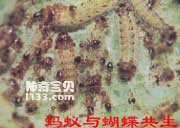
Ant
ant symbiont
Ants themselves are a large family of groups, and members of this large family are willing to make friends. According to surveys, about 3,000 species of animals are sacrificed in ant nests, including about 1,000 species of Coleoptera, ant beetles, etc., about 60 species of spiders, and about 9 species of crustaceans. In addition, there are other animals. , whose hospitality is such that it welcomes all comers; but not all of the visitors in the ant nest are true friends.
A. Friends of ants
There are two types of friends of ants: one is commensal, they live together with the ants, that is, the ants protect them, and they use their secretions for the ants to eat. Among them are midges of the order Diptera, treehoppers of the order Homoptera, psyllids, aphids, scale insects, etc., as well as larvae of small gray butterflies with scale problems. These insects are all friends that ants love, and they The time spent living in an ant nest is also very short. The other type is the so-called ant-loving animals, which are actually some eaters (or ants, real ants, ant friends), such as cryptid beetles, stick-horned beetles, oligosegmented ant beetles, and some triconid beetles. beetles, burrowing beetles, and pedeleoids, among others. These close friends can provide the ants with various excrement as food. At the same time, they often have red or yellow hairs that secrete liquid, from which the ants can get the juice they like. In order to nurture the larvae of these close friends, ants even sacrifice their own "children" (eggs and larvae) to feed them.
The word "ant" is composed of the word "worm" and the word "meaning". Some people say that ants are about "loyalty" and they will help other insects. In fact, this is the symbiotic relationship we mentioned earlier. There have been records in North America: There is a local aphid called corn root aphid, which is a major pest that harms corn. This pest is easy to freeze to death in winter, but people have discovered that a kind of ant called the kite ant will move the eggs of corn root aphids to its own nest when the weather is cold, and then move the eggs to warmer weather. When weeds begin to sprout and grow in spring, they move their eggs to the roots of weeds. After the eggs hatch, small nymphs are born. At this time, the corn is growing. The ants then transport the small aphids to the roots of the corn so that they can feed. This is how ants work tirelessly to serve aphids. Why? It turns out that whenever ants are hungry, they lick aphids' secretions to satisfy their hunger. Aphids provide food to ants, and ants protect aphids. There is a symbiotic relationship between them. When you go out to collect in the wild, you will often see ants on plants that have aphids swarming on them. Please pay attention to how ants eat aphid excrement? Then you can catch a few carnivorous ladybugs (seven-spotted ladybugs or small yellow ladybugs) from elsewhere, put them in a colony of aphids and ants, and pay attention to the ants. What are the behavioral responses? Should we ignore it and let the ladybugs act, or should we drive the ladybugs away? Tell us about this.
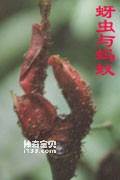
B. Ordinary diners
There are some useless and harmless eaters in the ant nest; ants do not pay much attention to them, such as ticks, springtails, leaf beetles, beetles, hoverflies, cryptopterans, beetles, and crickets. species, cockroaches, etc. These uninvited guests enter the ant nest to eat the secretions on the body surface of certain ants, and some of them pick up the food spit out by the worker ants.
C. Poachers in the ant nest
There is also a category of harmful eaters that are not welcomed by the ants, but rely on their agility, concealment and camouflage abilities to live in the ant nest for a long time. Most of them are predatory insects, including ant mimics. They steal food from the mouths of worker ants and devour weak, injured or ordinary worker ants. For example, Cryptoptera is an enemy hidden in the ant nest. In addition, there are some internal and external parasites and slave ants that live in the ant nest.
Ant Colony War
Argentine ants are widely distributed around the world. In South America, it is common for their colonies to attack each other. But when they conquer new territories, they behave differently. In California, they attack and occupy the territory of local ant populations, but rarely conflict with colonies of their own species. Researchers from the University of California explain: Because they are not warlike, they reproduce in large numbers and form very large colonies that work together.
The reason why ants are more powerful in numbers
A single ant is not very adaptable to the environment, but why can many ants together cope with many problems? Scientists recently explained this in the journal Nature. Scientists say that ants leave chemicals called pheromones wherever they go. Other ants can use these chemicals to judge whether their route is correct, because the greater the concentration of this substance, the greater the distance traveled. The more ants there are, it means it is a more reasonable route.
animal tags:
We created this article in conjunction with AI technology, then made sure it was fact-checked and edited by a Animals Top editor.